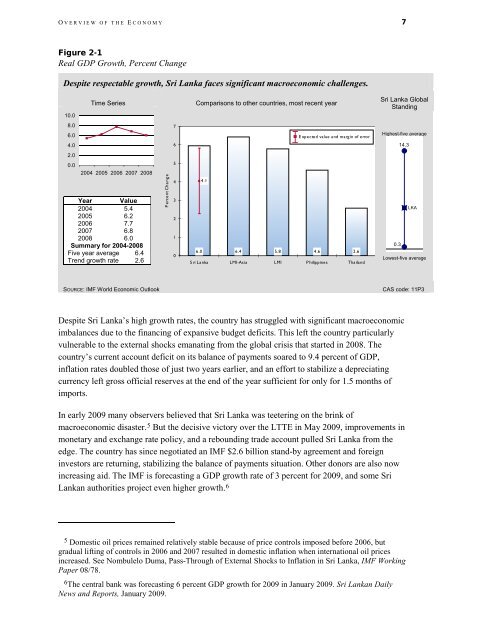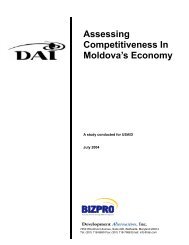Sri Lanka Economic Performance Assessment (2009)
Sri Lanka Economic Performance Assessment (2009)
Sri Lanka Economic Performance Assessment (2009)
You also want an ePaper? Increase the reach of your titles
YUMPU automatically turns print PDFs into web optimized ePapers that Google loves.
O VERVIEW OF THE E CONOMY 7<br />
Figure 2-1<br />
Real GDP Growth, Percent Change<br />
Despite respectable growth, <strong>Sri</strong> <strong>Lanka</strong> faces significant macroeconomic challenges.<br />
10.0<br />
8.0<br />
6.0<br />
4.0<br />
2.0<br />
0.0<br />
Time Series Comparisons to other countries, most recent year<br />
2004 2005 2006 2007 2008<br />
Year Value<br />
2004 5.4<br />
2005 6.2<br />
2006 7.7<br />
2007 6.8<br />
2008 6.0<br />
Summary for 2004-2008<br />
Five year average 6.4<br />
Trend growth rate 2.6<br />
Percent Change<br />
7<br />
6<br />
5<br />
4<br />
3<br />
2<br />
1<br />
0<br />
4.1<br />
Expected value and margin of error<br />
6.0 6.4 5.8 4.6 2.6<br />
S ri L a nka LMI-As ia LMI P hilippines Thailand<br />
<strong>Sri</strong> <strong>Lanka</strong> Global<br />
Standing<br />
Highest-five average<br />
0.3<br />
14.3<br />
LKA<br />
Lowest-five average<br />
SOURCE: IMF World <strong>Economic</strong> Outlook CAS code: 11P3<br />
Despite <strong>Sri</strong> <strong>Lanka</strong>’s high growth rates, the country has struggled with significant macroeconomic<br />
imbalances due to the financing of expansive budget deficits. This left the country particularly<br />
vulnerable to the external shocks emanating from the global crisis that started in 2008. The<br />
country’s current account deficit on its balance of payments soared to 9.4 percent of GDP,<br />
inflation rates doubled those of just two years earlier, and an effort to stabilize a depreciating<br />
currency left gross official reserves at the end of the year sufficient for only for 1.5 months of<br />
imports.<br />
In early <strong>2009</strong> many observers believed that <strong>Sri</strong> <strong>Lanka</strong> was teetering on the brink of<br />
macroeconomic disaster. 5 But the decisive victory over the LTTE in May <strong>2009</strong>, improvements in<br />
monetary and exchange rate policy, and a rebounding trade account pulled <strong>Sri</strong> <strong>Lanka</strong> from the<br />
edge. The country has since negotiated an IMF $2.6 billion stand-by agreement and foreign<br />
investors are returning, stabilizing the balance of payments situation. Other donors are also now<br />
increasing aid. The IMF is forecasting a GDP growth rate of 3 percent for <strong>2009</strong>, and some <strong>Sri</strong><br />
<strong>Lanka</strong>n authorities project even higher growth. 6<br />
5 Domestic oil prices remained relatively stable because of price controls imposed before 2006, but<br />
gradual lifting of controls in 2006 and 2007 resulted in domestic inflation when international oil prices<br />
increased. See Nombulelo Duma, Pass-Through of External Shocks to Inflation in <strong>Sri</strong> <strong>Lanka</strong>, IMF Working<br />
Paper 08/78.<br />
6 The central bank was forecasting 6 percent GDP growth for <strong>2009</strong> in January <strong>2009</strong>. <strong>Sri</strong> <strong>Lanka</strong>n Daily<br />
News and Reports, January <strong>2009</strong>.
















